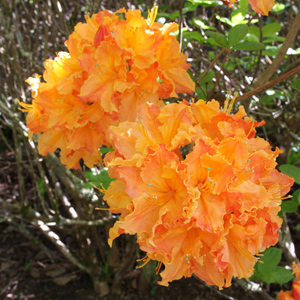
Azalea mollis, knap hill, ghent and Azalea ‘Klondyke’ are all deciduous azalea hybrids.
Loved for the attractive showy flowers that appear in spring Deciduous Azaleas or Azalea mollis are perhaps an under used garden plant. In cool to temperate climates these azaleas are easy to grow and require little care other than light pruning to keep in shape.
Origins of Deciduous Azaleas
These are medium sized deciduous shrub that flower early to late spring depending on conditions. All are hybrids of deciduous azalea species such as R. japonicum, R. canadense and R. prinophyllum.
With very attractive and colorful flowers appear on bare stems in spring and range in color from white through to tangerine and reds.
Deciduous Azalea Care
Deciduous Azaleas grow well in full sun to part shade in a slightly acidic soil pH 4.5 to 5.5. Protection from hot afternoon sun is desirable.
A humus rich well drained moist soil is best, so mulch around Deciduous Azaleas to provide a cool root run. Deciduous Azaleas can be pruned back after flowering to maintain shape and size.
Remember that Deciduous Azaleas are fairly shallow rooted, so try not to dig around the shrub itself. Well suited to smaller gardens most varieties can easily be kept to 2m and less with a little pruning.
Pruning
The only real reasons to prune deciduous azaleas is to remove dead or damaged wood. However over time some gardeners decide to reshape or resize, so if you must, use this method.
Firstly do this slowly, prune back one 1/2 of the azalea one year and the other 1/2 the following year. Try to find some of the buds that are on the stems and prune to them. To make it easy prune in spring, the dormant buds will be more evident, and new growth will commence within a few weeks.
After pruning it’s time to fertilize, a general purpose azalea fertilizer and a a good watering with liquid seaweed fertilizer.
Problems
- Deciduous azalea not flowering – This is usually caused by lack of light or very poor soil
- Yellow Leaves – Usually problems with soil ph or a lack of Iron (Chlorosis) which is typically yellow leaves with darker green veins.

